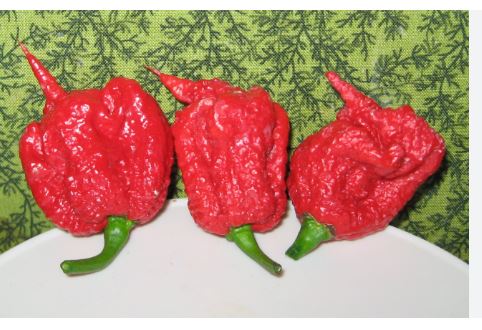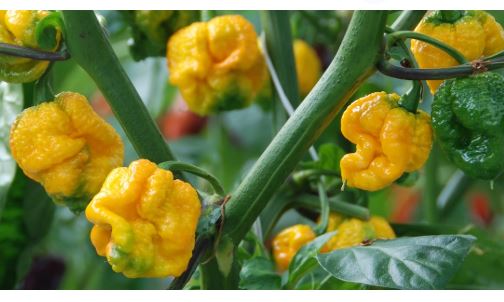
Pepper X, a fiery cultivar of chili pepper, has captured global attention as the hottest pepper in the world, recognized by Guinness World Records in August 2023. Bred by Ed Currie of the PuckerButt Pepper Company in Fort Mill, South Carolina, this pepper pushes the boundaries of heat and flavor, surpassing even its predecessor, the Carolina Reaper. With a staggering Scoville Heat Unit (SHU) rating and a complex flavor profile.
Pepper X belongs to the genus Capsicum, specifically the species Capsicum chinense, which is known for producing some of the world’s hottest peppers, including habaneros, Scotch Bonnets, and the Carolina Reaper. The Capsicum genus, part of the Solanaceae (nightshade) family, encompasses over 30 species, but C. chinense is prized for its wrinkled, pungent fruits and intense capsaicin content. Pepper X is a hybrid cultivar, resulting from over a decade of selective crossbreeding to enhance capsaicinoid levels, particularly in the locules (seed-holding tissues) and placenta. Its exact genetic makeup remains a trade secret, but it is believed to be a cross involving the Carolina Reaper and possibly other super-hot varieties like the Trinidad Moruga Scorpion. This classification places Pepper X among the elite of fiery chilies, distinguished by its extreme pungency and unique morphology.
Pepper X was developed by Ed Currie, a renowned chili breeder and founder of PuckerButt Pepper Company, in South Carolina, USA. Currie, who also created the Carolina Reaper (the previous world’s hottest pepper), spent over 10 years crossbreeding peppers to achieve Pepper X’s unprecedented heat and flavor. The pepper was officially unveiled on the YouTube show Hot Ones in 2023, where its record-breaking status was announced. Unlike many peppers with deep cultural roots, Pepper X is a modern creation, born from scientific breeding rather than traditional cultivation. Its development involved hundreds of hybrid crosses annually, with only a few succeeding after multiple generations to stabilize its intense traits. While its birthplace is a controlled greenhouse in South Carolina, Pepper X draws on the genetic heritage of Capsicum chinense peppers, which originated in the Amazon basin and spread across Central America, the Caribbean, and beyond.

Pepper X holds the title of the world’s hottest chili pepper, with an average Scoville Heat Unit (SHU) rating of 2,693,000, as certified by Guinness World Records through high-performance liquid chromatography (HPLC) testing at Winthrop University. Some samples have reportedly peaked at 3.18 million SHU, surpassing the Carolina Reaper’s maximum of 2.2 million SHU by nearly 400,000 units—equivalent to the heat of an entire habanero (100,000–350,000 SHU). For perspective, Pepper X is up to 1,077 times hotter than the mildest jalapeño (2,500 SHU) and three times hotter than a ghost pepper (1,000,000 SHU). This heat level rivals commercial pepper sprays, causing severe burning sensations, abdominal cramps, nausea, and even temporary numbness when consumed raw. Its extreme pungency, driven by high capsaicinoid content in the placenta and locules, demands cautious handling with gloves and protective gear.
Despite its ferocious heat, Pepper X offers a surprisingly nuanced flavor profile, a hallmark of Ed Currie’s breeding philosophy. The pepper initially delivers a sweet, fruity, and floral taste with hints of citrus, reminiscent of other Capsicum chinense varieties like habaneros. Some enthusiasts also note earthy undertones, adding depth to its profile. However, the flavor is fleeting, quickly overtaken by an overwhelming heat that can linger for hours. Pepper X’s appearance is rugged, with a bulbous, wrinkled surface and a scorpion-like tail, similar to the Carolina Reaper but sometimes more elongated, resembling a ghost pepper. Its green pods ripen to a yellowish-green hue, and the pepper’s many lobes and ridges increase the surface area for capsaicin production, enhancing its potency. The plants are compact, typical of C. chinense, and require hot, humid conditions for optimal growth, yielding peppers after 90–120 days.
Due to its extreme heat, Pepper X is not suited for casual cooking or everyday culinary use. Its primary application is in ultra-hot sauces, such as The Last Dab Xperience featured on Hot Ones, where it constitutes 91% of the formula, delivering intense heat while preserving its fruity-floral notes. These sauces are used sparingly to add a fiery kick to wings, tacos, or other bold dishes, appealing to thrill-seekers and chili enthusiasts. Pepper X is also used in small quantities in specialty salsas, spice blends, and even candies, where its flavor can shine without overwhelming the consumer. However, its potency requires extreme caution, as ingestion can cause significant discomfort, including heartburn and digestive distress. Currently, Pepper X is not available as raw peppers, seeds, or plants for public purchase, limiting its use to PuckerButt’s proprietary products. For those daring enough, it offers a unique culinary experience, but always with a warning: handle and consume with respect.
Controversy
Pepper X’s status as the world’s hottest pepper has sparked some debate within the chili community due to its limited availability and lack of independent testing. Unlike the Carolina Reaper, whose seeds were widely distributed and verified by multiple sources, Pepper X remains proprietary, with no seeds or pods released for third-party cultivation or analysis. Critics argue this lack of transparency raises questions about its true heat and consistency, especially since only one of three tested samples reached 2.69 million SHU, with others falling below 2.2 million. Despite this, its Guinness certification and HPLC testing provide credible evidence of its record-breaking heat. For now, Pepper X remains a branded phenomenon, accessible primarily through hot sauces, fueling both fascination and skepticism among pepper enthusiasts.

Cultivation of Pepper X
1. Climate and Temperature
Pepper X thrives in hot, humid climates, typical of Capsicum chinense origins in the tropical Americas. Ideal daytime temperatures range from 70–85°F (21–29°C), with nighttime lows above 60°F (15°C). Temperatures below 54°F (12°C) can stunt growth, while excessive heat above 100°F (38°C) may reduce pollination and fruit set. In cooler climates, use greenhouses or high tunnels to maintain warmth, especially since Pepper X’s long growing season (90–120 days post-transplant) requires consistent heat to mature its fiery pods.
2. Soil Requirements
Grow Pepper X in well-drained, loamy soil with a pH of 5.0–6.8, slightly more acidic than many peppers to optimize nutrient uptake. Incorporate organic matter like compost to enhance fertility and water retention. Capsicum chinense has shallow roots, so avoid heavy clay soils that retain water, as they can cause root rot. Conduct a soil test to ensure adequate phosphorus and potassium levels, using low- or no-phosphorus fertilizers if levels are sufficient, as excess nitrogen can lead to leafy growth at the expense of fruit production.
3. Seed Starting
Since Pepper X seeds are proprietary, growers of similar C. chinense super-hots should start seeds indoors 8–10 weeks before the last frost. Use a seed-starting mix and maintain soil temperatures of 80–90°F (27–32°C) with a heat mat for optimal germination, which can take 14–21 days due to the species’ slow germination. Provide 16 hours of bright light daily using grow lights to prevent leggy seedlings. Harden off seedlings gradually before transplanting to avoid shock.
4. Transplanting
Transplant Pepper X seedlings outdoors or into a greenhouse when soil temperatures reach at least 65°F (18°C) and nighttime lows are consistently above 60°F (15°C). Space plants 18–24 inches apart in rows 24–36 inches apart to allow for bushy growth, as C. chinense plants can reach 3–4 feet tall and wide. Ensure each plant receives full sun (6–8 hours daily) to maximize capsaicin production, which is enhanced by sunlight and heat stress.
5. Watering
Maintain consistent soil moisture without waterlogging, as Pepper X is sensitive to both drought and overwatering. Water deeply once or twice weekly, providing 1–2 inches of water, depending on soil type and weather. Sandy soils may require more frequent watering. Use drip irrigation or soaker hoses to keep foliage dry, reducing disease risk. Inconsistent moisture can lead to blossom-end rot or poor fruit quality, so monitor soil closely, especially during fruit set.
6. Fertilization
Feed Pepper X with a balanced fertilizer (e.g., 5-10-10 or 10-10-10) at planting, then switch to a low-nitrogen, high-potassium formula (e.g., 5-10-15) during flowering and fruiting to promote fruit development over vegetative growth. Apply fertilizer every 2–3 weeks, following soil test recommendations to avoid over-fertilization, which can reduce capsaicin levels. Organic options like fish emulsion or compost tea can also support healthy growth, especially in organic systems.
7. Mulching
Apply a 3–4-inch layer of organic mulch, such as herbicide-free straw or grass clippings, around Pepper X plants to retain moisture, suppress weeds, and regulate soil temperature. Black plastic mulch is particularly effective for warming soil in cooler climates and boosting yields by enhancing root zone heat, critical for C. chinense cultivars like Pepper X. Mulching also prevents soil-borne pathogens from splashing onto leaves during rain or watering.
8. Plant Density
For maximum capsaicinoid yield, consider high-density planting, as studies on Capsicum chinense suggest densities impacts fruit yield and pungency. A density of 15,000–18,324 plants per hectare (6,070–7,400 plants per acre) can optimize fruit number and dry fruit yield per area, as seen in cultivars like ‘Akanee Pirote.’ However, lower densities (11,000 plants per hectare) may increase individual plant yield. Experiment with spacing based on your goals, balancing yield and plant health.
9. Pest and Disease Management
Pepper X is susceptible to pests like aphids, whiteflies, and spider mites, and diseases such as bacterial leaf spot and viral infections (e.g., TSWV, PHYVV). Use resistant cultivars if available, and monitor for leaf curl symptoms, which indicate begomovirus infection. Integrated pest management (IPM) strategies, including neem oil, insecticidal soap, and beneficial insects, can control pests. Avoid overhead watering to reduce fungal risks, and rotate crops to prevent soil-borne diseases. Resistance to some viruses has been noted in C. chinense, but Pepper X’s specific resistances are unknown.
10. Pollination
Pepper X, like most Capsicum species, is self-pollinating, with small, white, five-petaled flowers that do not require external pollinators. However, gentle shaking of plants or introducing pollinators like bees can enhance fruit set, especially in greenhouses. High temperatures (86–100°F) can reduce pollen viability, so provide shade or misting during heatwaves to maintain flowering. C. chinense typically produces 2–5 fruits per node, a trait that may be pronounced in Pepper X’s hybrid vigor.
11. Pruning and Support
Prune Pepper X plants lightly to remove suckers and lower leaves touching the soil, improving air circulation and reducing disease risk. Avoid heavy pruning, as it can stress C. chinense plants and reduce yields. Provide stakes or cages to support bushy plants, especially during fruiting, as heavy fruit loads can cause branches to snap. Support is critical for Pepper X, given its potential for prolific, heavy pods similar to other super-hot hybrids.
12. Harvesting
Harvest Pepper X when pods reach full maturity, typically yellowish-green, as indicated by its reported appearance, though some sources suggest a red ripening in certain conditions. This occurs 90–120 days post-transplant, depending on climate and growing conditions. Use gloves and scissors to clip pods, avoiding skin contact with capsaicin-rich tissues, which can cause burns. Regular harvesting encourages continuous fruit production, but expect smaller, bumpier pods with scorpion-like tails, characteristic of Pepper X’s morphology.
13. Challenges and Considerations
Cultivating Pepper X presents unique challenges due to its proprietary nature and extreme heat. Seeds and plants are unavailable, so growers must rely on similar C. chinense super-hots for practice. Its cultivation requires meticulous attention to heat, humidity, and pest control, with a long growing season that may necessitate season-extension techniques like row covers or greenhouses in temperate regions. The pepper’s intense capsaicin content demands protective gear during handling, and its limited availability raises questions about scalability. Additionally, environmental factors like drought or excessive moisture can reduce capsaicinoid content, requiring precise management to maintain its record-breaking heat.